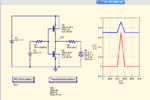oAwad
Full Member level 2
Hello,
If I have a simple CMOS inverter with input= '1'. Hypothetically speaking, if the output gets somehow an intentional glitch/noise that's greater than NMOS threshold voltage, can the input of the inverter toggel ?
I have simulated this behavior in SPICE, where input='1' and I insert a glitch at the output greater than threshold of NMOS...I thought the inverter would overcome such glitch and remain with same values (input =1' and output '0'). However, in the simulation the output was raised to '1' and the input changed to '0' (as if the inverter working backward: output -> input).
Can any experienced one tell me how this happened in some details ?
Thanks
If I have a simple CMOS inverter with input= '1'. Hypothetically speaking, if the output gets somehow an intentional glitch/noise that's greater than NMOS threshold voltage, can the input of the inverter toggel ?
I have simulated this behavior in SPICE, where input='1' and I insert a glitch at the output greater than threshold of NMOS...I thought the inverter would overcome such glitch and remain with same values (input =1' and output '0'). However, in the simulation the output was raised to '1' and the input changed to '0' (as if the inverter working backward: output -> input).
Can any experienced one tell me how this happened in some details ?
Thanks
